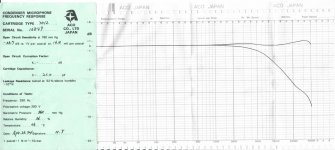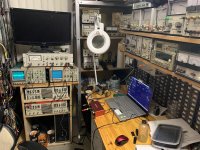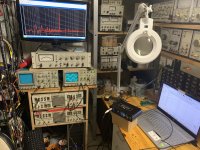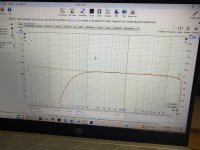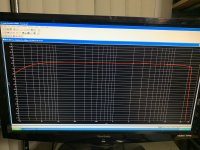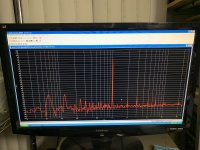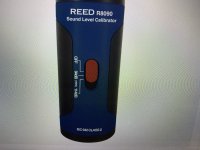I have an Aco Pacific 70121/2" measurement microphone which I purchased with mellisa back in 1995 is basically flat from 3HZ to 40KHZ. I plan to use it with REW software. Rew needs a Mic. calibration data to be installed. The cal data consists of frequency, amplitude and phase angle. I only have the Mic frq. response graph, no phase response. I need to buy a usb audio interface.
Question 1. How do I get this data into REW?
Question 2. The software called Vituixcad has a spl trace tool that can convert the frq. response graph into a .txt file. Windows 10 or google chrome won't let me install it. For security reasons.
Question 3. How do I convert Mic. sensitivity from dB rel. 1V/Pa into db spl? 7012 sensitivity is -36 dB.
Have not used the 7012 in 2 decades. Not willing to have it cal'd for $135. and not willing to buy a Chinese usb mic.
Your help will be greatly appreciated. Mellisa is a dos based program. I still have the pc but it won't boot up due to a dead bios battery. no longer have the serial mouse or the din plug keyboard or the crt monitor that I once had.
Best regards,
Art
Question 1. How do I get this data into REW?
Question 2. The software called Vituixcad has a spl trace tool that can convert the frq. response graph into a .txt file. Windows 10 or google chrome won't let me install it. For security reasons.
Question 3. How do I convert Mic. sensitivity from dB rel. 1V/Pa into db spl? 7012 sensitivity is -36 dB.
Have not used the 7012 in 2 decades. Not willing to have it cal'd for $135. and not willing to buy a Chinese usb mic.
Your help will be greatly appreciated. Mellisa is a dos based program. I still have the pc but it won't boot up due to a dead bios battery. no longer have the serial mouse or the din plug keyboard or the crt monitor that I once had.
Best regards,
Art
Lucky man! I had a 1" ACO mic for years, and the FR was virtually ruler flat to 15kHz or so. So I never bother with any calibration. REW does not require it, iirc. Yours is similar, barely a 1/2 dB rise at 2kHz, and the slight deviation at the top is in a range that's mostly inaudible anyway -- not worth sweating about imo. I presume you have the 200VDC phantom PSU they usually require? With that, it is so quiet (under 20 dBA self noise) that your ambient room noise will always be higher. My 1" version had 5~7 dBA self noise. Its noise was lower than anything else through the entire recording/measuring chain.
Hi There:
Yes I have the 4012 pre amp, (may be just a source follower with no gain) and PS9200 power supply. I am new to REW, used mellisa 30 years ago on daily basis. So its rock and roll just use the 7012 on rew without worrying about the cal file?
Art
Yes I have the 4012 pre amp, (may be just a source follower with no gain) and PS9200 power supply. I am new to REW, used mellisa 30 years ago on daily basis. So its rock and roll just use the 7012 on rew without worrying about the cal file?
Art
I would.Yes I have the 4012 pre amp, (may be just a source follower with no gain) and PS9200 power supply. I am new to REW, used mellisa 30 years ago on daily basis. So its rock and roll just use the 7012 on rew without worrying about the cal file?
You will want a quiet mic preamp in the audio interface to take advantage of the low noise mic. That will allow for distortion & noise readings to a lower level.
Something like the MOTU M2 2x2 USB-C Audio Interface should do. Lots out there with similar specs/features. Just keep the 48V phantom power switched off.
I'd anticipate the only cal file you need to prepare is for your soundcard interfacing to the 9200. I had excellent low noise results with a 4012 capsule and preamp, going via 9200 to an EMU0404 soundcard, and using CRL 511E calibrator with QC:3 cavity adaptor for ½” microphone, with noise floor at least -100dB below 104dB cal tone in region near to tone. I had to repair my 9200 - it had a bad RC4193 - so re-engineered the schematic for the 9200.
https://dalmura.com.au/static/ACOP 9200 pcb schematic.pdf
https://dalmura.com.au/static/ACOP 9200 pcb schematic.pdf
Thanks for the schematic.
Question: The 30 years old FR graph is still valid? or is like keeping a leftover in the refrigerator and when later you open the container you discover it has green fuzz on it!
I don't want to pay for Mic cal charges + shipping/insurance. I paid over $2k for the Mic/preamp/polarization power supply back in 1995 which is around $4k today.
When I receive the audio interface I will test the Mic preamp THD+N and S/N ratio with my audio precision both in time and frq. domain.
Question: The 30 years old FR graph is still valid? or is like keeping a leftover in the refrigerator and when later you open the container you discover it has green fuzz on it!
I don't want to pay for Mic cal charges + shipping/insurance. I paid over $2k for the Mic/preamp/polarization power supply back in 1995 which is around $4k today.
When I receive the audio interface I will test the Mic preamp THD+N and S/N ratio with my audio precision both in time and frq. domain.
It's like a yearly calibration for any instrument - you either pay for it (eg. as it makes you money to have cal'd equipment) or you live with it (perhaps using 1 or more similar mics etc to act as round-robin comparisons whenever you get around to it). All diy people with vintage equipment are in the same position with respect to calibration.
Houston we have a problem!
My Scarlett 2i2 just arrived. I am officially pi$$ed. This thing sucks in terms of performance. THD+N of <.002 my foot! The output is quite noisy, and @ .1v output the THD+N with measurement bandwidth of 400hz-30 KHZ is 0.22%. and line out level clips at less than 3v peak to peak. Noisy as crap.
I have a major flu and congested at the moment I hope I am not doing something wrong. I try to do some more measurement tomorrow.
If I end up sending this back, I may have to go back to Mellisa and forget about REW. I am spitting nails and crapping bricks right now!
Art
PS. Is it possible that scarlett is designed for guitar players that love distortion? Or something wrong with my unit? This thing is made in China.
My Scarlett 2i2 just arrived. I am officially pi$$ed. This thing sucks in terms of performance. THD+N of <.002 my foot! The output is quite noisy, and @ .1v output the THD+N with measurement bandwidth of 400hz-30 KHZ is 0.22%. and line out level clips at less than 3v peak to peak. Noisy as crap.
I have a major flu and congested at the moment I hope I am not doing something wrong. I try to do some more measurement tomorrow.
If I end up sending this back, I may have to go back to Mellisa and forget about REW. I am spitting nails and crapping bricks right now!
Art
PS. Is it possible that scarlett is designed for guitar players that love distortion? Or something wrong with my unit? This thing is made in China.
Attachments
Perhaps ease up on the naive vitriol, and do some googling and homework on what others have measured and experienced. Try and find some threads/posts where people have posted their loopback and other measurement results for that particular soundcard, and go through the learning curve of recreating their results.
Mark: I use the cable that came with it. Its powered from my HP laptop with the ac adaptor plugged in. No idea as to output current rating of the usb port. I woke up at 4:30 AM. I am still running test with my AP. The max gain I get out of it is 30 dB. Max output b4 clipping is around 600 mV driven by balanced ap generator set to -30 dBu.
Art
Art
One happy camper!
Replaced the non working Scarlett 2i2 with Motu M2 that just arrived. This one works!
Attached are the Frq. response, in both REW and AP, and AP FFT spectrum graphs.
The High level of line frequency 60, 120HZ and its harmonics perhaps coming from my HP laptop power supply.
It appears that I am in business now.
Need to learn to use REW and XSIM to redesign xovers for my M&K satellites , JBL L200, and VIFA M13SG MTM and may be my beloved Klipschorn, Altec 802G, 416.
Wish me luck.
Thanks for your help, to get to this point. also need to recover from the flu.
Art
Replaced the non working Scarlett 2i2 with Motu M2 that just arrived. This one works!
Attached are the Frq. response, in both REW and AP, and AP FFT spectrum graphs.
The High level of line frequency 60, 120HZ and its harmonics perhaps coming from my HP laptop power supply.
It appears that I am in business now.
Need to learn to use REW and XSIM to redesign xovers for my M&K satellites , JBL L200, and VIFA M13SG MTM and may be my beloved Klipschorn, Altec 802G, 416.
Wish me luck.
Thanks for your help, to get to this point. also need to recover from the flu.
Art
Attachments
Do you have a microphone SPL calibrator? Sometimes you can get one within reason and it serves nicely as a sanity check for the mic and the rest of the signal chain.
R u talking about 1/2" mic calibrator (94db spl) called piston something (photo attached) or sound level meter?
No I don't have have neither.
No I don't have have neither.
Attachments
Last edited:
Yes, a handy little sanity check if you can afford it. I got a cheap one off the 'bay and even though not exact (out of cal), it lets me know what's coming through and reading out is reasonable.
Mic calibrator: These have been around for ~20 years. They are very accurate. I compared them to Bruel-Kjaer & 2 other reference mic calibrators at the U of BC physics labs & my 2 samples of this "ND9" were within 1/2 dB. https://www.ebay.com/itm/232805516957 Price has gone up but not by much.
My mic sensitivity is -36 dB rel to 1v/PA, meaning if I couple the mic to the calibrator (94 dB spl) the ac voltage at the output of the mic preamp ( a source follower) is 36 dB below 1vrms which is approximately 16mv. Then mic is connected to the mic input of audio interface with some gain then goes into rew. Since the mic sensitivity is known to rew ( u need to enter this I think) and the gain of the internal audio interface mic pre amp is the signal input to rew, and the distance from mic to the speaker (1m) is given (known). Rew is supposed to calculate the spl on its own. Am I correct or talking crap?
If what I tried to explain is correct why do you need a mic calibrator?
Kindly enlighten me.
If what I tried to explain is correct why do you need a mic calibrator?
Kindly enlighten me.
- Home
- Design & Build
- Software Tools
- Using Aco Pacific 7012 Mic with REW
